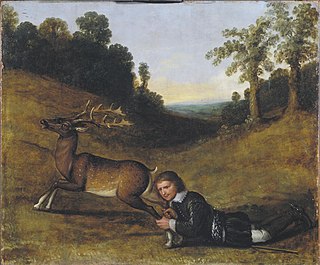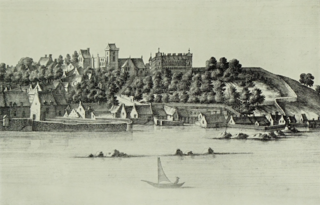
John Michael Welsh of Irongray was a leader of the Scottish Covenanter movement. Dunlop, an early 20th century writer, says: "It is a noteworthy fact that there exists no memoir of John Welsh of Irongray, though from the Battle of Rullion Green till Bothwell Bridge he was the most conspicuous Covenanting minister in Scotland. Had he glorified God in the Grassmarket, or fallen in some scuffle with Claverhouse's dragoons, or even like his friend Blackadder of Troqueer languished in prison on the Bass Rock, some pious hand would have been moved to write his story." Dunlop also wrote: "The events of Welsh's life must be sought for in the pages of Wodrow and Kirkton and in the letters and State papers of the reign of Charles II. After spending a fortnight hunting him in the British Museum, I have come to sympathise with Clavers and his dragoons. Mr John Welsh is a most elusive gentleman."

Alexander Shields or Sheilds or Sheills was a Scottish, Presbyterian, nonconformist minister, activist, and author. He was imprisoned in London, in Edinburgh and on the Bass Rock for holding private worship services. After his escape from prison he wrote A Hind Let Loose which amongst other things argues for the rights of people to resist tyrants including the bearing of arms and the resistance of taxes. It even argues that assassination, in extreme cases, is sometimes justified. Shields was one of the ministers who supported the Cameronians who disowned the king. They were brutally put down. All three of the Cameronian field-preachers, of which Shields was one, rejoined the church after the Revolution. Shields served as a chaplain to King William's armies in the Low Countries. Shields was later called to be a minister at St Andrews but did not stay there long as he joined the second Darien Expedition. After its failure he died on Jamaica under 40 years of age.

John Blackadder (1615–1685) was an eminent Presbyterian Covenanter preacher in Scotland during the period of the Commonwealth of England (1649–1660). Of the times MacPherson said that "after the first rejoicings of the Restoration were over, the Covenanters — Resolutioners as well as Protesters — were speedily disillusioned, and it became evident that the aim of Charles II and the junta of self-seeking noblemen who were in control of the affairs of Scotland was to establish in Scotland something approximating to an oriental despotism. The Presbyterian system, in which an Assembly of ministers and elders controlled the affairs of the Kirk, had to be supplanted by an Episcopal, with a hierarchy controlled by the Crown and easily manipulated in the interests of tyrannical rule." Despite a government ban he continued to preach in the fields. He was arrested and imprisoned in 1681 and died in jail on the Bass Rock.

John Stewart was a 17th-century Scottish minister.

Robert Dick of Prestonpans was a 17th-century merchant and inspector of salt works to Lord Carringtoune. He was arrested on 4 September 1676 for attending an open-air service in the Pentland Hills.

William Bell was a field preacher and 17th century minister.

John Dickson was a 17th-century minister from Rutherglen in Scotland. He was a Covenanting field-preacher and a close associate of John Blackadder. For preaching outdoors without a licence he was imprisoned on the Bass Rock from 1 September 1680 to 8 October 1686.

Robert Traill was a church minister at Cranbrook in Kent. He was born at Elie in Fife in 1642. He was incarcerated on the Bass Rock, an island in the Firth of Forth from July 19, 1677 to October 5, 1677. His work was often quoted by J. C. Ryle and is still published in the 21st century.

Rev Archibald Riddell (1635–1708) was a Scots-born 17th-century Presbyterian church minister in Scotland and America. His name is sometimes spelled Riddel. He preached at conventicles in a time when such actions were considered high treason. He was imprisoned on the Bass Rock and was later banished to New Jersey.

Rev Thomas Hog of Kiltearn (1628–1692) was a controversial 17th century Scottish minister.

Michael Potter was a covenanter. He graduated from Edinburgh on 27 July 1663. He was licensed to preach the gospel in 1673. He was a tutor to the family of George, the Laird of Dunglass of that ilk. He was ordained by presbytery for the adherents in the parish of St. Ninians in 1673. He was elected a schoolmaster to Culross by the magistrates. This led to them being summoned before the Privy Council in 1677.

James Fraser of Brea (1639–1699) was a Covenanter.

James Mitchell or James Mitchel,, was a religious covenanter who tried to assassinate Archbishop James Sharp.

Alexander Forrester (1611–1686) was a Scottish minister of the 17th century.

Robert Gillespie was a 17th-century Presbyterian preacher. His father was George Gillespie the famous Westminster Divine. His mother was Margaret Murray, who had £1000 sterling voted by Parliament immediately after George's death, for the support of herself and family, but, owing to the distractions of the time, it was never paid. Robert was baptised 15 May 1643.

William Lin or William Line was a 17th-century Presbyterian lawyer from Scotland. Phillimore calls him a Writer to the Signet which would make him a senior lawyer. He may have been from in or around Kirklistoun.
Thomas Ross of Nether Pitkerrie, was born about 1614. He was the son of George Ross of Nether Pitkerrie. He continued in Kincardine after the establishment of prelacy and owes his leaving to a meeting with John M'Gilligan.
William Spence was a Scottish schoolmaster in Fife. In the month of May 1685, he was summoned to appear before the Privy Council. Phillimore says he "had committed the offence of teaching his pupils the doctrines of Presbyterianism, and attending the forbidden conventicles." Dickson says he "was committed to the Bass where he remained for more than a year, when he petitioned for his liberty on the ground of ill-health." He was sent to the Bass Rock at the same time as Peter Kid and had fourteen months of imprisonment. On the 20th of July 1686, “My Lords ” agreed to his release “upon his finding caution to compear before the Council, when cited; and, in the meantime, to live peaceably and not to keep a school, under a penalty of five thousand merks, Scots money, in case of failure.” He was liberated along with John Greg. After he was set free he had to periodically reappear before the Council to retain his liberty.

John M'Gilligen was a 17th-century Presbyterian minister. He resisted the demands of the Episcopalian authorities and was imprisoned on the Bass Rock. His name is sometimes also spelled as John MacKilligen or John M'Killican or John MacKillican or even John M'Gilligine.

Alexander Moncrieff was a minister with the Church of Scotland. The youngest son of Matthew Moncrieff of Kintillo, Alexander Moncrieff took a prominent part in the church history of the seventeenth century.



















